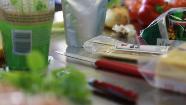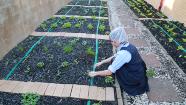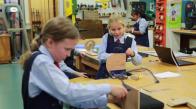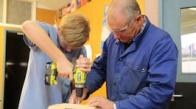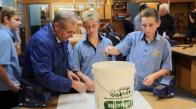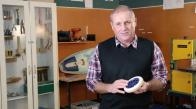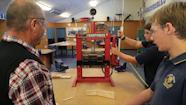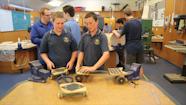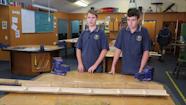Noel Amor the technical manager at Cedenco Foods talks about how they ensure an efficient operation and considerations when purchasing plant.
Costing in a global environment – Cedenco foods
Transcript
Noel Amor: Like all businesses you have to make a profit. We have shareholders, and we have aspirations and we’re all here earning salaries and wages and we’d all like more too. So, I think we’ve all got the same goal. When you’re making food if you’re going to do some designer food with low volume for something quite specific you’d be targeting a different market at high value. But, generally what happens with food, most of it is a commodity to some extent so the business here of Cedenco which is a bulk food ingredients supplier, essentially taking large volumes of raw materials, converting them into a shelf stable form or a frozen form supplying it to the end manufacturer, like for example Heinz or McCain's or Simple or Unilever, or SPC all these kind of companies and they would take this industrial commodity that we produce and produce the retail product.
So, thinking about the whole chain we’ve got to be quite efficient and the scope of the operation, it can’t be too small, because it will be uneconomic on a world basis and if that’s the case then we’re going to find some other country who’ll be able to do it cheaper and then we can import it into our country. So those are the threats if you like. At the same time when you do process it you need to have enough scale in the, in the manufacturing side to keep your costs down at a reasonable level. So that involves, continuous processing, not batch processing to a greater extent, it means we have to work 24 hours, 7 days a week and in fact when there’s a crop there you pretty much work everyday. So, we’ve got many crops here that’ll take 100 days, or even longer.
Tomatoes for example, sweet corn, squash all these crops here, so we’ll grow them and we’ll get, harvest them as early as we practically can to meet the specifications and we’ll run the season as long as we practically can again, to meet the sort of market specifications, and then in that period there, really its about once you have your assets there, it’s about how you can optimise the use of them, because if you can run them faster and more continuously and have less losses, then you’re ahead of the game essentially.
There’s a lot of focus on preparing and measuring the raw material. Once we start running on in the rates that we run at and, and having that information live and continuous, so we can validate that we are doing what we expect to do and also having a big watch on the recovery, so if you have to take the skin off or the seed out, or we have to boil some water out uhm you manage those, understand those and you make sure you meet your targets on those as well. So just talking about new equipment or new technology that we need to make new products, there’s probably two different categories to think about. One would be, is it off the shelf?
For example, if we’re making tomato paste of frozen corn or frozen peas, it’s highly likely we’ll find the technology somewhere in the world or a range that we can choose from. So, in that situation we would use the best skills we have with the key people in this business and if we needed to, outside resources as well and we would evaluate what’s available, what our competitors are using, what our, maybe our local competitors are using as well and decide what’s the right thing for us, what would make the quality specifications that our customer base needs, what can live up to the type of raw material and efficiencies and recoveries that we are looking for.
So there’s that kind of area, the other area is things like, say kiwi fruit would be a good example, or some of the squash products we do, where there isn’t technology available necessarily there might be part of the technology available, or even nothing at all. So then we have to say well how do we go about creating a production line that can make the type of products we’re looking at.
So we have several examples of that pretty much every day I would think here. I could think of squash, kiwi, sweet corn where we’re doing this all the time. That’s always a difficult challenge, the thing would be in many cases to look at even parts of maybe that process you could find somewhere, and learn from that, maybe develop the other part. There is some situations where we’ve tried to develop the whole thing ourselves, more recently we’re using more external people, let's say Cedenco in primarily in the areas of squash for Japanese markets where we make dices and slices in a very different range of shapes and sizes, there isn’t technology necessarily available for that, and we have some quite specific customers, that need specific criteria in the product. It means that we have to develop the technology. Kind of the first choice is to do it with the customer, if they have the capability and in some cases we are quite fortunate that I think in some of our sweet corn products and pumpkin products that we do have customers that are buying into that, so it’s very much a joint effort together. The most success comes from that. Where you both work through it together. But we also have situations where we’ve got market opportunities for, for example kiwi fruit products. Different shapes or sizes where there isn’t really the technology available. Where were kitted up for certain things in kiwifruit, but others we’re not and in this situation we have to try and scour the world for what’s available and if it isn’t we have to try and generate a structure that we can generate that technology, so more recently on those we’re engaging some of the CRI’s in the form of Callahan Innovation and some of the other people attached to that structure and we’re finding some successes there. But it’s just a matter of finding people that have the ability and the knowledge and the want to assist in that area. We just mentioned other options to develop technology how to use local resources or some of the government resources. There’s two fold reasons to look that direction. One is there is funding that the Government is putting forward for X related food projects, which I thinks fantastic. But also there’s some very good skills that sit in some of those structures. So it’s a matter of just identifying the people and the skill sets and applying those to our industry and where at this stage a lot of those going to dairy, agri, fish that kind of area, so I think there’s a lot more untapped skill available in that area, so that’s interesting.
Related videos
Real food, real fast (02:35)
Students were set a brief to develop a faster, fresher, healthier takeaway based on an analysis of a traditional recipe....
A food bag for a family dinner (03:31)
With a focus on using seasonal produce and their families as stakeholders, students produced great recipes and food bags for a family dinner....
My context and issue (04:57)
Year 13 students share about the contexts and issues they have chosen in their food technology programme.
Engaging contexts in product design (03:09)
Abby Dingle discusses materials and tools that engage students in product design.
Combining knowledge and practice (01:58)
Steve Andrew explains how understanding materials is essential for effective technological practice.
Linking hands-on experiences and understandings (03:54)
Hands-on experiences allow the students to see materials understandings in action.
Play, experiment, explore (02:55)
Steve Andrew lets the students see, feel, and play with products to develop their understandings in materials.
Finding materials to meet the specs (02:36)
Steve Andrew shares how students identify material specifications in a brief and then test materials to find those that are suitable....
School–industry relationship cuts both ways (03:36)
Steve Andrew and Terry Rillstone describe the way the relationship between St John's College and The Shop has benefits for them both....
Pushing the boundaries with materials (02:53)
Steve Andrew describes how his senior students have the confidence to select and work with unfamiliar materials.
Exploring unfamiliar materials (02:44)
Year 12 students from St John's College describe what they know about bamboo and how they are applying this knowledge to their projects....
Students and teachers talk about testing materials in year 11.
Manipulating, forming, and transforming
Students in year 10 describe manipulating, forming, and transforming materials.
Evaluating materials for an outcome
Steve Andrew and students talk about using their knowledge to test materials for their projects at year 12.
Year 10 students describe some of the attributes for the snake skates they are developing.
Senior students select their own issues
Year 12 students talk about the issues that they have selected for their projects.

